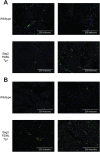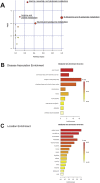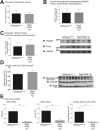Cardiomyocyte-Specific Human Bcl2-Associated Anthanogene 3 P209L Expression Induces Mitochondrial Fragmentation, Bcl2-Associated Anthanogene 3 Haploinsufficiency, and Activates p38 Signaling
- PMID: 27321750
- PMCID: PMC4973657
- DOI: 10.1016/j.ajpath.2016.03.017
Cardiomyocyte-Specific Human Bcl2-Associated Anthanogene 3 P209L Expression Induces Mitochondrial Fragmentation, Bcl2-Associated Anthanogene 3 Haploinsufficiency, and Activates p38 Signaling
Abstract
The Bcl2-associated anthanogene (BAG) 3 protein is a member of the BAG family of cochaperones, which supports multiple critical cellular processes, including critical structural roles supporting desmin and interactions with heat shock proteins and ubiquitin ligases intimately involved in protein quality control. The missense mutation P209L in exon 3 results in a primarily cardiac phenotype leading to skeletal muscle and cardiac complications. At least 10 other Bag3 mutations have been reported, nine resulting in a dilated cardiomyopathy for which no specific therapy is available. We generated αMHC-human Bag3 P209L transgenic mice and characterized the progressive cardiac phenotype in vivo to investigate its utility in modeling human disease, understand the underlying molecular mechanisms, and identify potential therapeutic targets. We identified a progressive heart failure by echocardiography and Doppler analysis and the presence of pre-amyloid oligomers at 1 year. Paralleling the pathogenesis of neurodegenerative diseases (eg, Parkinson disease), pre-amyloid oligomers-associated alterations in cardiac mitochondrial dynamics, haploinsufficiency of wild-type BAG3, and activation of p38 signaling were identified. Unexpectedly, increased numbers of activated cardiac fibroblasts were identified in Bag3 P209L Tg+ hearts without increased fibrosis. Together, these findings point to a previously undescribed therapeutic target that may have application to mutation-induced myofibrillar myopathies as well as other common causes of heart failure that commonly harbor misfolded proteins.
Copyright © 2016 American Society for Investigative Pathology. Published by Elsevier Inc. All rights reserved.
Figures













Similar articles
-
Advances in the role and mechanism of BAG3 in dilated cardiomyopathy.Heart Fail Rev. 2021 Jan;26(1):183-194. doi: 10.1007/s10741-019-09899-7. Heart Fail Rev. 2021. PMID: 31808029 Review.
-
P209L mutation in Bag3 does not cause cardiomyopathy in mice.Am J Physiol Heart Circ Physiol. 2019 Feb 1;316(2):H392-H399. doi: 10.1152/ajpheart.00714.2018. Epub 2018 Nov 30. Am J Physiol Heart Circ Physiol. 2019. PMID: 30499714 Free PMC article.
-
BAG3P215L/KO Mice as a Model of BAG3P209L Myofibrillar Myopathy.Am J Pathol. 2020 Mar;190(3):554-562. doi: 10.1016/j.ajpath.2019.11.005. Epub 2020 Jan 14. Am J Pathol. 2020. PMID: 31953038
-
Zebrafish models of BAG3 myofibrillar myopathy suggest a toxic gain of function leading to BAG3 insufficiency.Acta Neuropathol. 2014 Dec;128(6):821-33. doi: 10.1007/s00401-014-1344-5. Epub 2014 Oct 2. Acta Neuropathol. 2014. PMID: 25273835
-
BAG3: a new player in the heart failure paradigm.Heart Fail Rev. 2015 Jul;20(4):423-34. doi: 10.1007/s10741-015-9487-6. Heart Fail Rev. 2015. PMID: 25925243 Free PMC article. Review.
Cited by
-
The role of heat shock proteins and co-chaperones in heart failure.Philos Trans R Soc Lond B Biol Sci. 2018 Jan 19;373(1738):20160530. doi: 10.1098/rstb.2016.0530. Philos Trans R Soc Lond B Biol Sci. 2018. PMID: 29203715 Free PMC article. Review.
-
Understanding the molecular basis of cardiomyopathy.Am J Physiol Heart Circ Physiol. 2022 Feb 1;322(2):H181-H233. doi: 10.1152/ajpheart.00562.2021. Epub 2021 Nov 19. Am J Physiol Heart Circ Physiol. 2022. PMID: 34797172 Free PMC article. Review.
-
Non-Targeted Metabolomics Analysis of the Effects of Tyrosine Kinase Inhibitors Sunitinib and Erlotinib on Heart, Muscle, Liver and Serum Metabolism In Vivo.Metabolites. 2017 Jun 22;7(3):31. doi: 10.3390/metabo7030031. Metabolites. 2017. PMID: 28640223 Free PMC article.
-
ACVR2B antagonism as a countermeasure to multi-organ perturbations in metastatic colorectal cancer cachexia.J Cachexia Sarcopenia Muscle. 2020 Dec;11(6):1779-1798. doi: 10.1002/jcsm.12642. Epub 2020 Nov 16. J Cachexia Sarcopenia Muscle. 2020. PMID: 33200567 Free PMC article.
-
Advances in the role and mechanism of BAG3 in dilated cardiomyopathy.Heart Fail Rev. 2021 Jan;26(1):183-194. doi: 10.1007/s10741-019-09899-7. Heart Fail Rev. 2021. PMID: 31808029 Review.
References
Publication types
MeSH terms
Substances
Grants and funding
LinkOut - more resources
Full Text Sources
Other Literature Sources
Medical
Molecular Biology Databases
Miscellaneous

